Sensitive quantitation of nitrosamines in multiple foodstuffs using the SCIEX 7500 system
Jack Steed1, Ernst Meiss2, Angelika Schönhals2, David Schütz2 and Jianru Stahl-Zeng3
1SCIEX, UK; 2Eurofins, Germany; 3SCIEX, Germany
Published date: March 22, 2024
Abstract
In this technical note, chromatography and mass spectrometry methods were developed to quantify 15 nitrosamines in malt, sausage and fish. Limit of quantitation (LOQ) values as low as 0.01 µg/L in solution were achieved for multiple compounds due to the sensitivity of the system used, with linear ranges spanning up to 4 orders of magnitude. Samples were spiked post-extraction at 0.05, 0.5 and 5 µg/kg concentrations, and accuracies between 70% and 130% and %CV values <10% were observed for most compounds analyzed.
Introduction
Nitrosamines are a group of compounds that animal studies suggest can be genotoxins. These compounds are putative contaminants of numerous food products and, due to their carcinogenicity, are a cause for concern for regulators and consumers alike.1 This concern is demonstrated in Figure 1, as the 3 matrices tested all show varying levels of NDMA contamination. The pervasiveness of nitrosamine compounds highlights the possible need for analysis and control of these compounds in multiple food products.
Figure 1. Extracted ion chromatograms (XICs) of solvent blank compared to un-spiked food sample. XICs are shown for NDMA (75 > 43 m/z). In each row, the solvent blank is shown on the left, highlighting the absence of interference or contamination. The un-spiked food samples are shown on the right, demonstrating the presence of NDMA in all samples analyzed. The average signal-to-noise (S/N) ratio (N=2) of the malt, sausage and fish blanks were 278.4x, 19.8x and 22.2x, respectively. These results indicate that LOQ levels in matrix as low as ~0.1 µg/kg could be achieved when using a criterion of ≥10x S/N ratio.
Key benefits of the quantitation of nitrosamines using the SCIEX 7500 system
- Accurate and precise sample quantitation: Samples were spiked post-extraction at 0.05, 0.5 and 5 µg/kg. Accuracies between 70% and 130% and %CV values <10% were observed for most analytes.
- Flexible analysis of multiple food matrices: Quantitation of 15 nitrosamines was performed in malt, sausage and fish extracts
- Ultra-high sensitivity levels: LOQ values as low as 0.01 µg/L in solution were achieved, with linear ranges spanning up to 4 orders of magnitude
Methods
Standard preparation: Standard solutions were diluted in water to provide a range of concentrations between 0.01–100 µg/L. A 10 µg/L internal standard (IS) mixture was used.
The standards tested included: N-nitrosodimethylamine (NDMA), N-nitrosomorpholine (NMOR), 1-nitrosopyrrolidine (NPYR), Nnitrosomethylethylamine (NMEA), N-nitroso-N-methyl-4- aminobutyric acid (NMBA), N-nitrosodiethylamine (NDEA), Nnitrosopiperidine (NPIP), N-nitrosoethylisopropylamine (NEIPA), diisopropylamine (DIPNA), N-nitrosodipropylamine (NDPA), Nnitrosodibutylamine (NDBA), N-nitrosodiphenylamine (NDPhA), 1-methyl-4-nitrosopiperazine (MeNP), N-nitrososarcosine (NSAR) and N-nitrosomethylphenylamine (NMPA).
The internal standards used included: N-nitrosodimethylamine D6 (NDMA D6), N-nitrosomorpholine D8 (NMOR D8), 1- nitrosopyrrolidine D8 (NPYR D8), N-nitrosomethylethylamine D3 (NMEA D3), N-nitrosodiethylamine D10 (NDEA D10), N-nitrosopiperidine D10 (NPIP D10), N-nitrosodipropylamine D14 (NDPA D14), N-nitrosodibutylamine D18 (NDBA D18) and N-nitrosodiphenylamine D6 (NDPhA D6).
All standards were purchased from commercial sources.
Sample preparation: Sample preparation protocols were modified from existing in-house methods (Eurofins, Hamburg) that are typically used for the analysis of chemical residues in food.
Spiked sample preparation: First, 90 µL of the food extract was added to 10 µL of a standard and IS mixture. The concentration of the standard was 0.5, 5 or 50 µg/L and the concentration of the IS was fixed at 100 µg/L. The resulting solution was then vortexed for 10 seconds to mix. The final solution concentrations were 0.05, 0.5 and 5 µg/kg standard and 10 µg/kg IS.
Chromatography: Separation was performed using a Shimadzu Nexera 40 series UHPLC and a Phenomenex Kinetex™ Biphenyl (100 x 2.1 mm, 2.6 µm, P/N: 00D-4622-AN) column with a Phenomenex Biphenyl SecurityGuard™ ULTRA pre column (P/N: AJ0-9209). Mobile phase A was 0.1% formic acid in water and mobile phase B was 0.1% formic acid in methanol. The injection volume was 10 µL and the column temperature was 40°C. The flow rate was 0.5 mL/min.
Table 1. Chromatographic gradient for the analysis of nitrosamines in food extracts using the SCIEX 7500 system.
Mass spectrometry: The optimized source and gas parameters are listed in Table 2. The optimized analyte-dependent multiple reaction monitoring (MRM) parameters are included in Table 3. Q0D is a parameter unique to the SCIEX 7500 system and the simple mode is used to reduce background and interference. Reference 2 provides more detail and demonstrates the optimization of the Q0D parameter.
Data processing: Data collection and analysis were performed in SCIEX OS software, version 3.3.
Table 2. Source and gas parameters for the analysis of nitrosamines in food extracts using the SCIEX 7500 system.
Table 3. MRM parameters used for the analysis of nitrosamines in food extracts using the SCIEX 7500 system. Transition 1 was used as the quantifier, transition 2 was used as the qualifier
Results
To assess the quantitative performance of the analysis for all 15 nitrosamines in the calibration standards, a concentration range between 0.01 and 100 µg/L was utilized. Using this range, the LOQ and linear range were determined for each transition analyzed. Table 4 shows the individual LOQs and calibration ranges observed. The LOQs ranged from 0.01–1.00 µg/L and were determined based on the >10x S/N ratio criterion. An R2 value ≥0.99 was observed for the full calibration range, with detector saturation observed for a few of the more sensitive analytes at concentrations >20 µg/L. The solvent blank showed no interference for any transition analyzed.
Three sample matrix extracts were chosen for the analysis, including malt, sausage and fish. Each matrix extract was spiked at 3 different levels (low: 0.05 µg/kg, medium: 0.5 µg/kg and high: 5 µg/kg) to assess the precision and accuracy at multiple concentrations across the calibration curve. Each concentration level was injected 3 times and for all compounds except NDPhA and NSAR, a CV value <10% was achieved at concentrations greater than the LOQ. The NDPhA spike exhibited relatively high variability at the 0.5 µg/kg level in all 3 matrices, resulting in CV values between 10–15%. In contrast, the NSAR spike demonstrated high matrix interference in the malt samples. As a result, the assessment of NSAR in malt was not possible and further development of analyses for this analyte is needed. However, %CV values <10% were achieved for NSAR spiked in the sausage and fish samples.
Figure 2 shows a combination of standard and sample XICs and precision data for NDMA, highlighting the high levels of sensitivity, linear range and precision achieved.
Finally, the percent accuracy was assessed for each compound in all the matrix extracts analyzed. Table 5 summarizes the results achieved, with accuracies between 70% and 130% observed for most analytes in the post-extraction spikes. However, some analytes fell outside of this specification either due to suppression or high matrix interference.
Table 4. The LOQs achieved in solution, calibration range tested and observed % accuracies for each transition analyzed. LOQs were assessed based on a >10x S/N ratio criterion. The calibration range was determined by an R2 value >0.99. Each concentration was injected twice to determine the average % accuracy.
Figure 2. Standard, matrix extraction blank and post-extraction spiked sample results for NDMA. The XICs (top) highlight the responses of the solvent blank injection (left) and an NDMA standard present at the method LOQ (0.2 µg/L, right). An R2 value >0.99 was achieved for NDMA between 0.2 µg/L and 100 µg/L, shown by the calibration curve (middle). XICs (bottom) highlighting representative responses of the sausage matrix are shown, including an un-spiked sausage sample (left), a 0.5 µg/kg post-extraction spiked sausage sample (middle) and a 5 µg/kg post-extraction spiked sausage sample (right). Finally, the table summarizes the %CV values achieved for each post-extraction spike level assessed in the sausage matrix (0.05, 0.5 and 5 µg/kg). The data shown are from the quantifier transition (m/z 75>43).
Table 5. Summary concentration and accuracy data for compounds analyzed across matrices. For each compound analyzed and in each matrix type, the average concentration (Conc. µg/kg) and average % accuracy (% Acc.) achieved are reported. Averages were calculated across 2 replicates for blank matrix samples and across 3 replicates for post-extraction spiked samples. Corrections were applied in instances in which the compound of interest was observed in the un-spiked sample.
Conclusion
The method demonstrated:
- Flexible analysis of 15 nitrosamines in multiple food matrices, including malt, sausage and fish
- Linear ranges spanning 4 orders of magnitude (R2 > 0.99) with LOQ values as low as 0.01 µg/L
- High precision and accuracy, with %CV values <10% and accuracies ranging between 70% and 130% for post-extraction spikes at 3 concentrations (0.05 µg/kg, 0.5 µg/kg and 5 µg/kg)
References
- Nitrosamines in food raise a health concern, EFSA news article, 28th March 2023
- Enhanced sensitivity for nitrosamine analysis in a metformin active pharmaceutical ingredient (API). SCIEX technical note, MKT-28016-A.
- Enabling new levels of quantification. SCIEX technical note, RUO-MKT-02-11886-A.
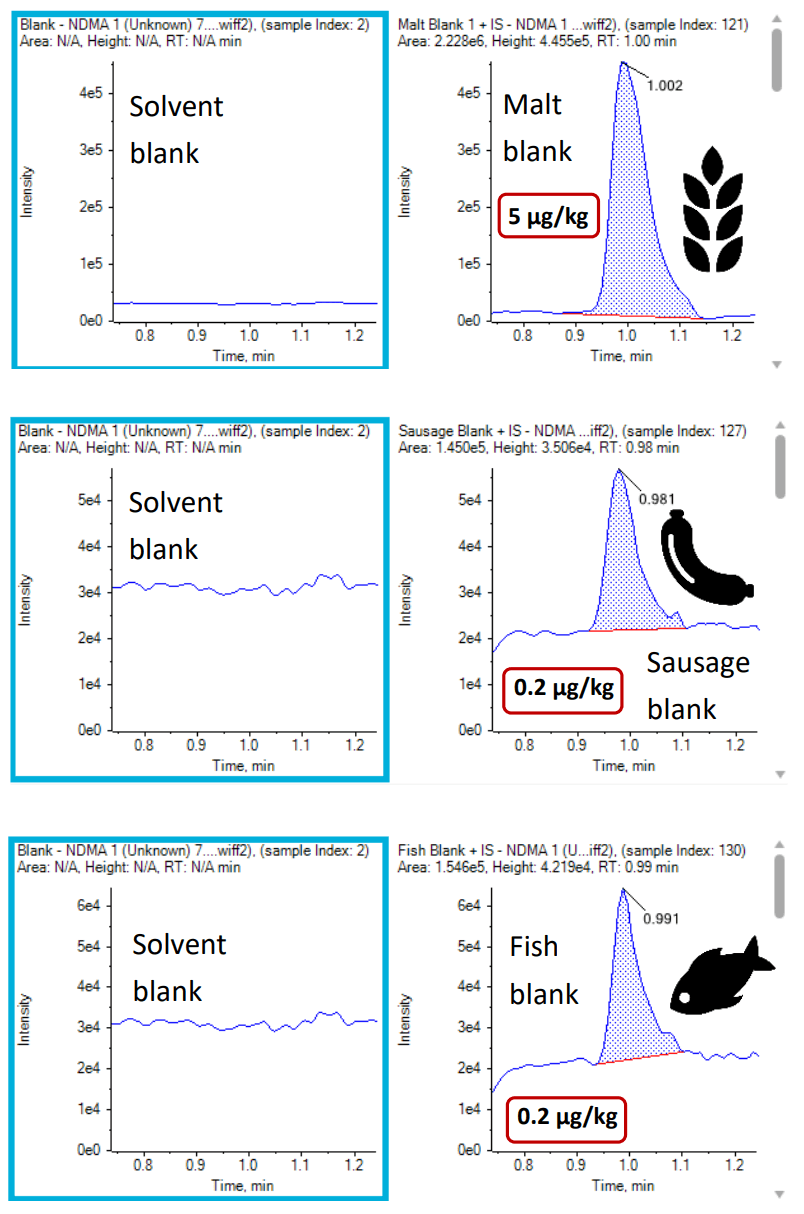 Click to enlarge
Click to enlarge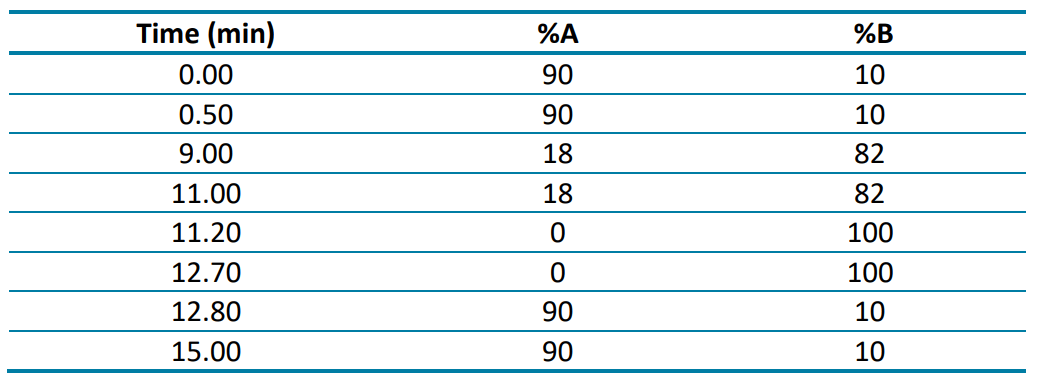 Click to enlarge
Click to enlarge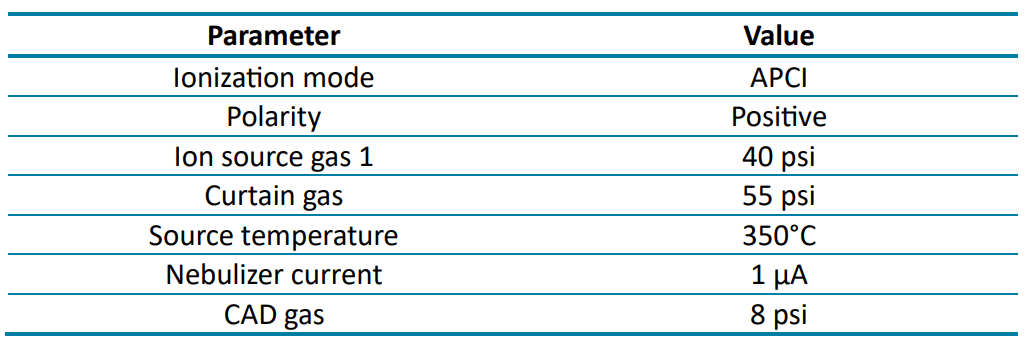 Click to enlarge
Click to enlarge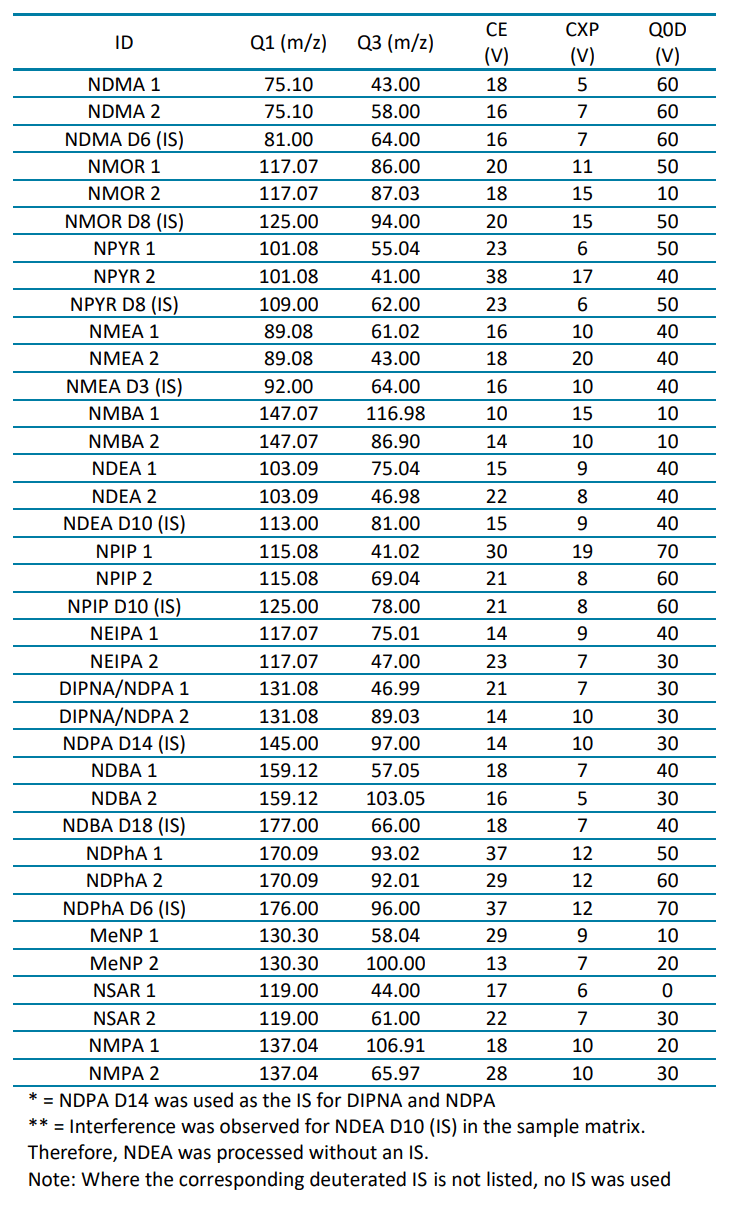 Click to enlarge
Click to enlarge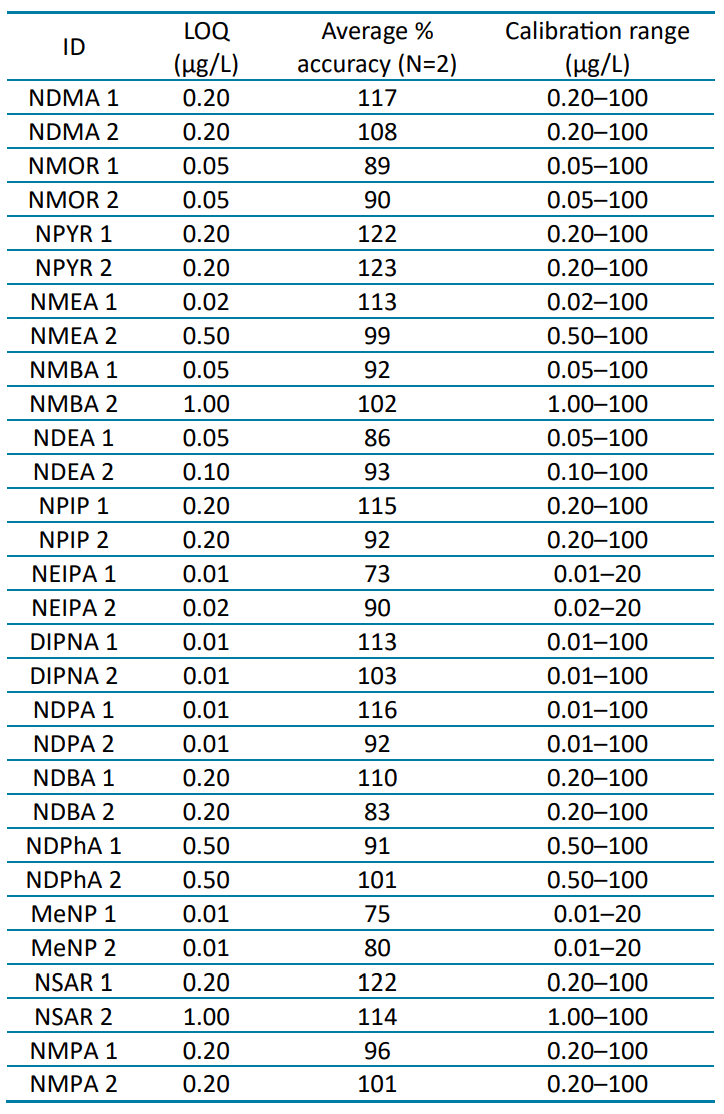 Click to enlarge
Click to enlarge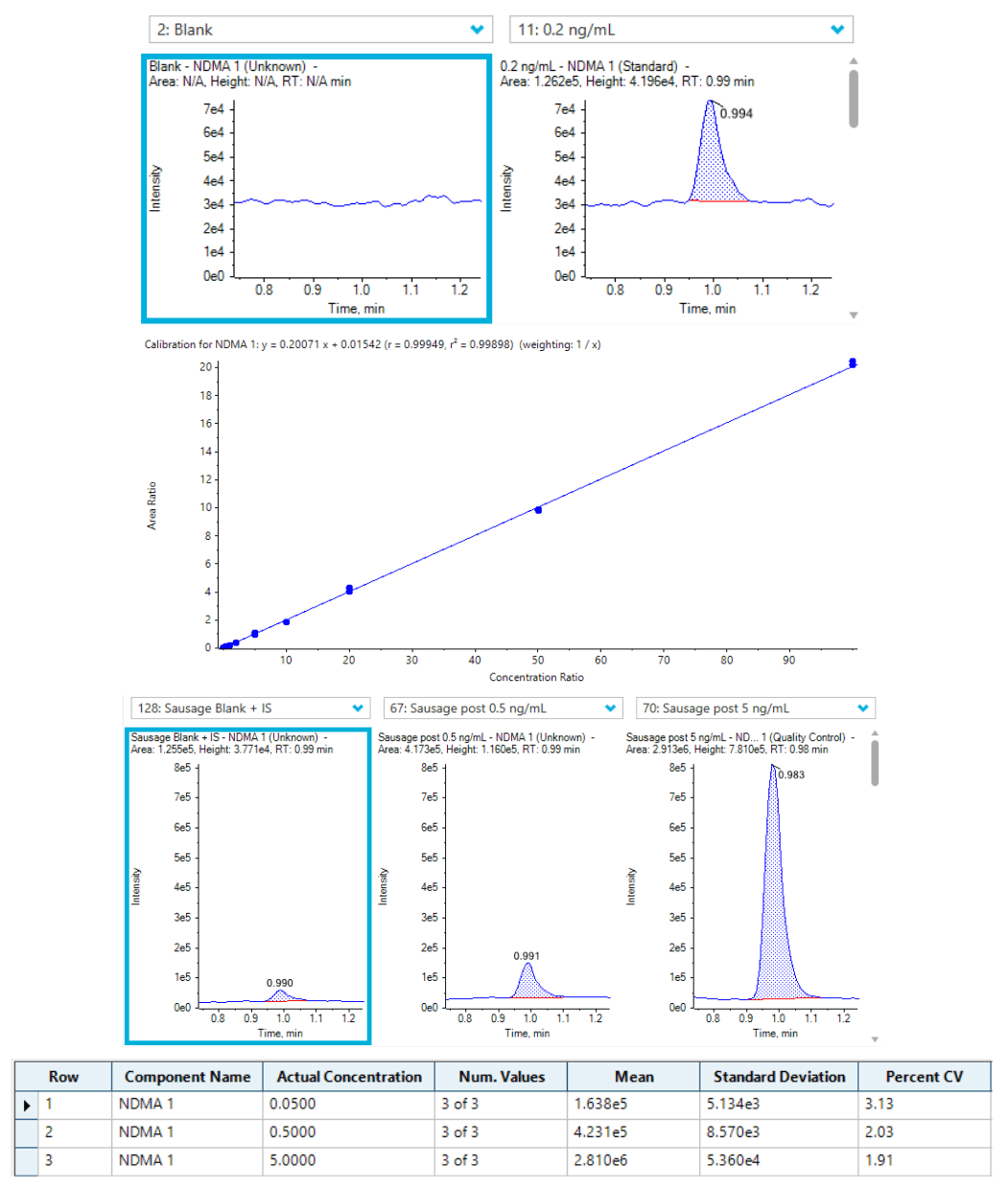 Click to enlarge
Click to enlarge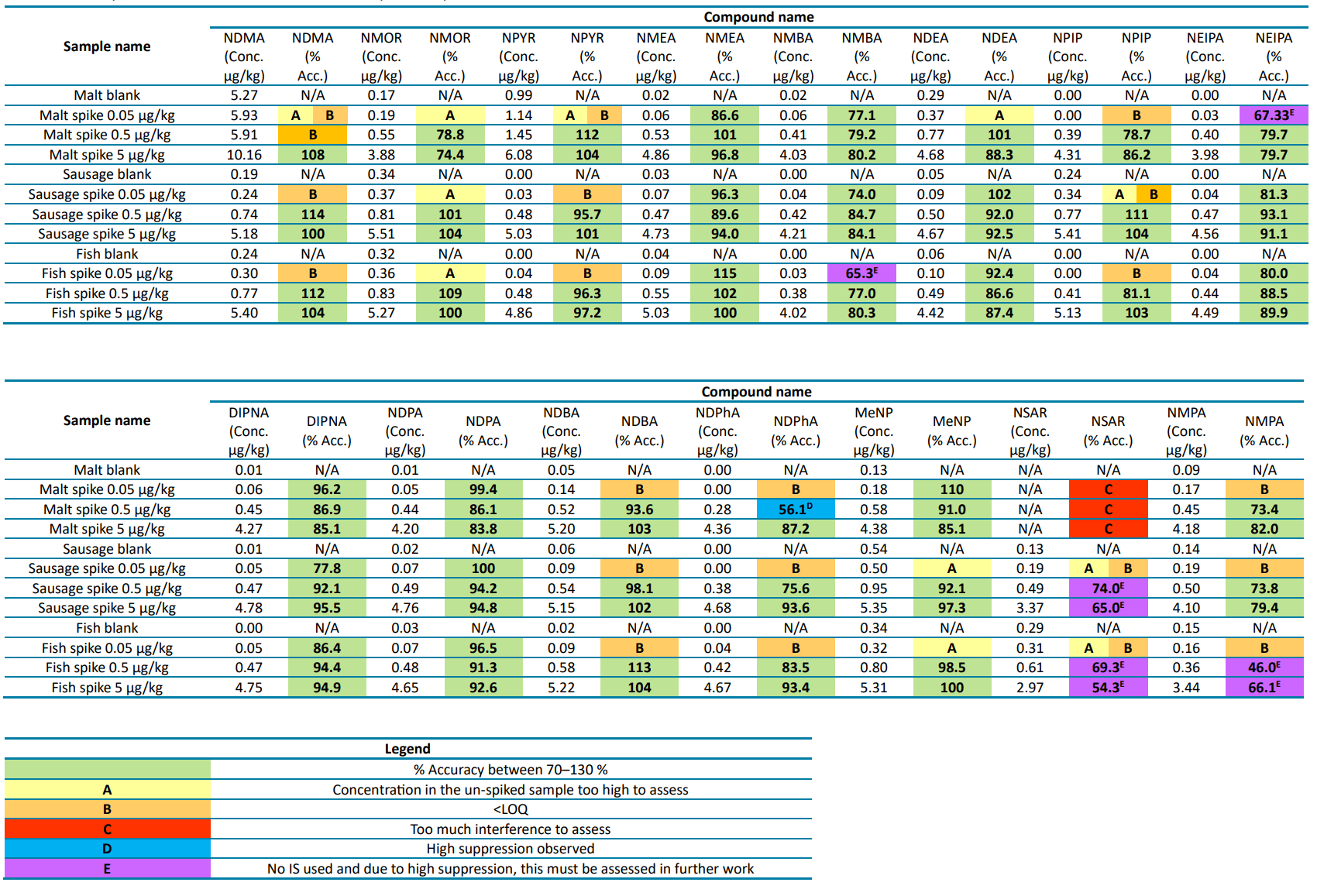 Click to enlarge
Click to enlarge